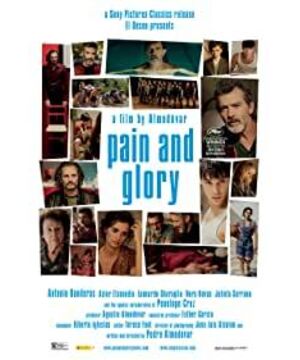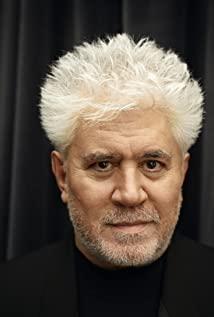(First published in Iris)
At the beginning of Pedro Almodovar's new work "Pain and Glory", the audience was immediately caught by a few simple audiovisual elements, connected with the film, and formed a kind of physical sensory sensitivity. The sound first brings us into the world of the film: a high-frequency sound first invades our ears, and then, the colorful and changeable title designed by Juan Gatti carries the impact of the flow of Alberto Iglesias' string music to occupy the whole It was a big screen, and the beauty of the music was a little breathless. At the end of the film, the sound of Almodovar's most iconic red color announced the beginning of the movie.
El Salvador, played by Antonio Banderas, hangs in the pool’s water, in a certain state of meditation. The camera rises from the bottom of the pool to photograph his weightless body, but the movie did not choose to let the camera rise all the way in a smooth manner-it was A sudden close-up interrupted, and in an instant, we saw the slender scar left by the actor's spinal surgery. This editing is like a scalpel, cutting through a mirror that should have been streamlined. It is not difficult for us to think of Almodóvar’s film predecessor-Spanish surrealist master Buñuel in "An Andalu Dog" "A shocking stab at that eye." But here, this seemingly abrupt edit unfolds the word "pain" in the title in a subtle way.
Almodovar, as always, introduced the characters at a simple and fluent rate. The elderly film director Salvador completed the restoration of a film, and his former male protagonist Alberto (Achel Etseandi) Played by Ya) regained contact, and his childhood memories were also unfolded in the flashback. Obviously, an "eight-and-a-half"-style autobiographical structure has emerged. However, unlike Fellini’s dreamy time and space shuttle, the introduction that “activated” Salvador’s memories was almost always drugs, pain, and dizziness. The movie very clearly confirmed this introduction, in other words, it was The destruction of the body caused by illness opens the door to memories. This is not the same as the Almodovar that we are familiar with from so many works. He once emphasized physical pleasure and the collision-like passion brought by the conflicts of color, coincidence and drama, but even with these techniques The elements with the author have not been completely abandoned, but his focus this time has been placed on the incompleteness and fragility of his body.
But in any case, the body in the movie, as Almodova’s drawing board, still tries to create a sensory experience for the audience, but even if we see the protagonist staggering slightly with inconvenient legs and feet, picking a pill on the ground still has to The pillow was placed on the ground to protect his knees... But the pain was not a deep bitterness, but rather comical and exaggerated, presented in a science lecture-style animation, Banderas was quick and a little lazy. The Spanish introduced the names of various diseases in detail: insomnia, chronic pharyngitis, otitis, gastroesophageal reflux, peptic ulcer... And from here we once again heard the high-frequency sound that can inhale people—— He also suffers from tinnitus. What all this means to the movie, in the final analysis, is for a kind of explicit but pure authenticity.
In Almodovar’s movies, we always see this kind of sincerity, perhaps the best example, from the impressive firefighting performance of the transgender girl La Agrado on the stage in "Everything About My Mother". When we see Salvador’s "pain encyclopedia"-like monologues today, perhaps we will also think of the moment when she counted the cost of every plastic surgery on her body on that stage, and her gorgeous declaration of sincerity: if you If you don't like it, you can pretend to snore! No matter how much exaggeration and drama there are in Almodovar’s movies, everything is driven by this sincerity. Even if we see a more somber version of Almodova this time, this sincerity is still present, and It is extremely necessary. The fear of disease that was shrouded in "About" that year came to the forefront of the movie. Almodovar showed the disease and healed himself at the same time.
Yes, this time Almodovar is facing himself. If Banderas’s hairstyle is not obvious enough, in several official posters of the movie, the shadow behind Banderas is Almodo. The shadow of the tile. The mirror image of Almodovar in the film is quite obvious. The film in El Salvador refers to the "Law of Desire" (Film Comment mentioned that it happened to be restored and re-screened in 2017), and the name of the lover in the film Federli Co/Marcelo reminds people of Fellini... Now, returning to "Eight and a half" (also appeared in the form of a poster in the film), Almodova seems to behave like his predecessors. The distance travels between reality and memories: his past movies, his past friends, his mother (played by Penelope Cruz in the memory), his hometown... This movie author watches and repeats In our own past, we are faced with some conflicts, large and small, but we gradually realize an inevitable separation, just as reality and flashback seem to be two insurmountable parallel time and space: the male protagonist failed to show himself The re-screening of the film had to be "present" on the phone, and the audience could not see the audience stand up and ask questions. He could only use the editing to "see" their funnyness; at the same time, he couldn't face the autobiography of his writing. Text; and when his leading male actor finally tells his story like a stand-in, he can’t watch it either... What Salvador/Almodova can do is to pass through the mirror-like audience to indirectly and indirectly He makes the hidden connection himself.
In one of the most touching memories of the movie, the main body of the memory—the image of the past did not even appear. If we have "unspeakable concealment" in language, then in the movie, these "unspeakable concealment" are things that cannot be filmed. After several rounds of conflict, we saw Alberto finally got his wish, performing Salvador's short monologue "Addiction", and the double relationship between Salvador and Almodovar was reproduced in the movie exactly as it was. If the previous series of memories can only be said to be fragments, then this time we finally get a story, and in the movie, the most sincere way of telling a story may only be the most primitive telling; and the most sincere viewing is to watch Follow the process of his storytelling. Here, Almodovar makes his stand-in (the stand-in) stand in front of the big red background and the blank screen, just like "Unspeakable Hidden", the "addiction" here cannot be filmed, let alone played and shown— —When we thought that there would be a flashback, until we realized that it was not, the movie only introduced a face, and in this face, we saw all the most sincere stories. This little technique is touching.
If we use this monologue as a turning point for splitting the movie in half (let us call it an operation), in the second half, we and the hero begin to break away from the pain of forbearance and move towards peace. With calm healing and recovery, if Almodovar’s purpose of filming this autobiography shows a certain potential for self-paralysis and imitation, then as the film comes to an end, reconciliation and confrontation will replace drugs and conflict. But the film has always maintained its keen sincerity, and finally gathered together in an amazing memory-a boy saw the body of an adult man for the first time in his life, and for a moment, he fainted. The whole scene seems to be rough psychological and image description, but it is beautiful and delicate. Although strange feelings are often shy, when you muster up the courage to watch it intently, there is unparalleled delicacy, and finally it is unified into sincerity. Perhaps in a seemingly "flat", subtractive atypical Almodovar movie, this scene most reminds us of all the reasons why we love these movies.
View more about Pain and Glory reviews











